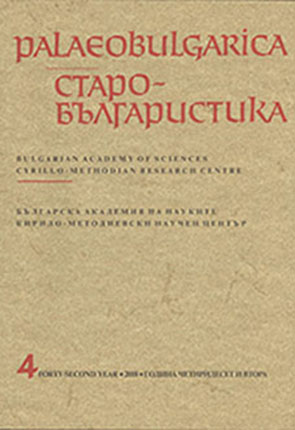Правни субекти в славянския превод на Прохирона
Legal Subjects in the Slavonic Translation of the Procheiros nomos
Author(s): Mariyana Tsibranska-KostovaSubject(s): Language studies
Published by: Кирило-Методиевски научен център при Българска академия на науките
Summary/Abstract: The full Slavonic translation of the Byzantine legal compendium Procheiros nomos (870–879, or 907) is a valuable witness of the high culture of translating juridical text developed by the Slavs during the Middle ages. Its earliest representative is the Ilovitsa copy from 1262, which is a part of the South Slavic Kormchaya with commentaries, also known as the Zakonopravilo of St. Sava of Serbia. The Ilovitsa kormchaya is a new type of law miscellany, a reliable witness for the increasing presence of translated texts of civil law. The Procheiros nomos is one of them. It has neither been fully published in Old Slavonic, nor translated into modern Bulgarian for the needs of Bulgarian juridical and philological studies. The present article focuses on the legal subjects (the persons defined as a necessary element of legal phenomena). In lexical terms they could be described as various subgroups of nomina agentis. The lexical and semantic fields of terminology allow for an approach that links the vocabulary of the text to socio-cultural factors and the public spheres of its application. This approach seems to be particularly appropriate in studying the medieval legal heritage. The linguistic material, excerpted selectively, is classified in the following groups: general denominations for social roles and differentiations (gender opposition, opposition master-servant, free man-slave, judges, witnesses, etc.); legal subjects exerting power; subjects of concrete social status (professional terms, criminal elements, heretics); kinship terminology. Of special interest are the terms of the Roman-Byzantine, in particular Justinian’s law, and their translation into Slavonic. The Slavonic translation of the Procheiros nomos exemplifies the ideological programme of the Ilovitsa kormchaya to give predominance to domestic lexical material, enriching it with terminological functions. In connection with this, some familiar lexemes are loaded with new context significance. Contextualisation most often reveals a well-considered choice. Thus a high register terminology with a specific field of application is created. Procheiros nomos comes next in importance after the first Slavonic translated texts of the 9th–10th centuries. In the area of legal matters and considering the abundance of terms, it remains unsurpassed in some areas. The Slavonic Procheiros relies on continuity and has a very unifying character, so it was transferred to different geographic areas. The stability of its lexical and terminological stock is undisputed evidence that it was known in various Slavonic states belonging to the Byzantine Commonwealth.
Journal: PALAEOBULGARICA / СТАРОБЪЛГАРИСТИКА
- Issue Year: 2018
- Issue No: 4
- Page Range: 37-72
- Page Count: 36
- Language: Bulgarian
- Content File-PDF

